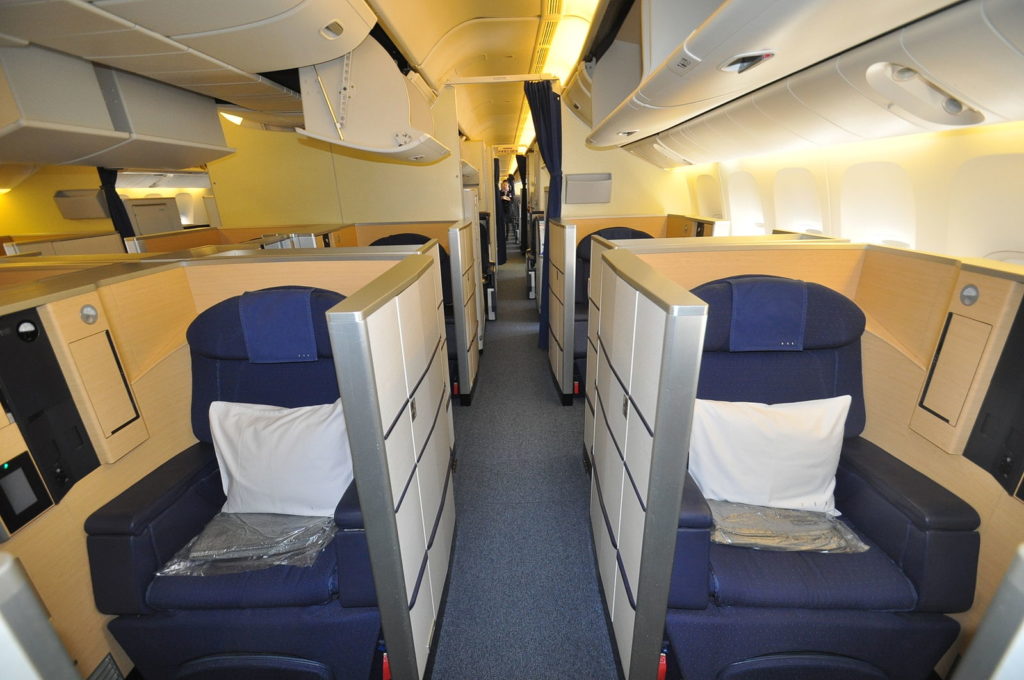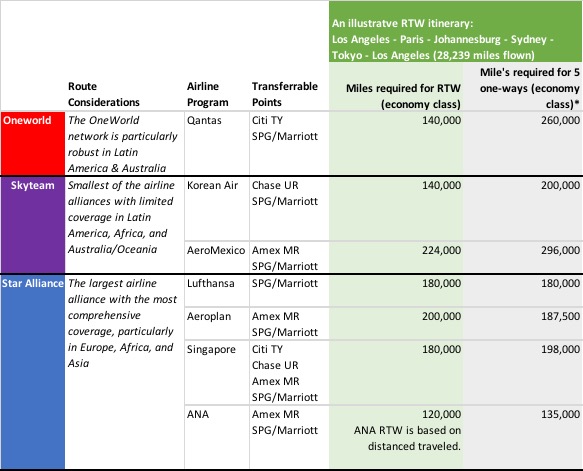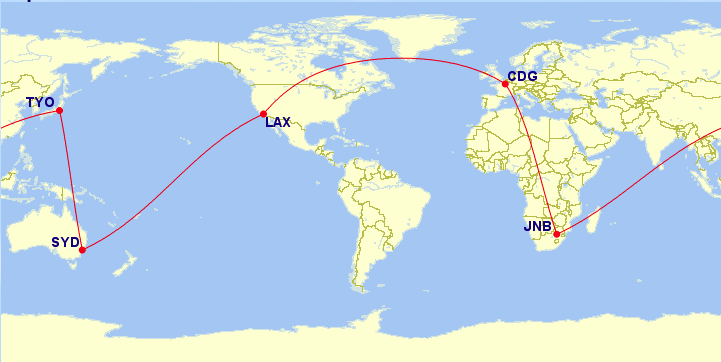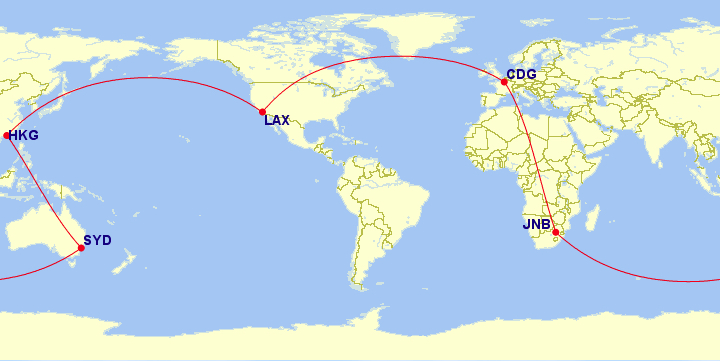Circling the globe is the ultimate dream trip for many travelers. An around-the-world ticket, known in the airline business as a “Round-the-World” or “RTW” ticket, is a special fare offered by select airlines and all airlines alliances specifically designed to enable travelers to circumnavigate the globe.
The primary advantage in booking RTW tickets is the potential to save substantially on the cash or points required to book a long, multi-stop trip.

Many airlines will allow you to circumnavigate the globe on a single, continuous ticket. Image by Matteo Fusco, Unsplash
This is the first of a 4-part series that will delve into how to book round-the-world tickets using credit card points and frequent flyer miles.
- When Does It Make Sense To Book a Round-the-World Ticket
- Which Airlines Offer Round-the-World Tickets; What are the Rules
- Alternatives to Booking Round-the-World Tickets (Do-It-Yourself Guide)
- Booking Round-the-World Tickets for Maximum Value (with ANA Mileage Club)
Not long ago, Round-the-World tickets offered unmatched value. A ticket that may otherwise cost several hundred thousand credit card points could be locked down for as few as 150,000 miles or better — even in business or first class.
Today the deals aren’t quite as sweet and many of the best round-the-world tickets have been discontinued. There are still some round-the-world gems, however, that can be booked with points and miles.
This process is very doable for even casual points and miles travelers, but it is time consuming given the number of searches required. To save time, you can always consider an award booking service like Juicy Miles or Points Pros.
Who Offers Round-The-World Tickets and For How Much?
Round-the-World tickets are offered through frequent flyer programs at some airlines. For those with transferable travel rewards from credit cards like The Gold Card or Platinum Card from American Express, Citi ThankYou Premiere, or Chase Sapphire Preferred, have several options to book a round-the-world ticket.
Points earned through hotel programs like Marriott Rewards and Starwood Preferred Guest can also be transferred to many of these frequent flyer programs.

It is possible to fly ANA First Class, pictured here on the Boeing 777-300ER as part of a round-the-world journey. Image by 衛兵隊衛士
The table below summarizes programs that still offer RTW redemptions. To illuminate the potential savings, the table compares a business class round-the-world fare with the price for the same itinerary, booked in separate legs. Our pretend journey takes us from Los Angeles to Paris, Johannesburg, Sydney and Tokyo.

In most cases, our five-city itinerary would be less when purchased as a round-the-world ticket. Notice that the inverse is true when booking with Lufthansa Miles and More.
The value is there for economy travelers, also. In some, but not all cases, long trips can be significantly more economical when booked as a round-the-world ticket.

For economy trips, it is more economical to book a round-the-world ticket in most programs, exclude Lufthansa and Air Canada Aeroplan.
When Does it Make Sense to Book Round-The-World Tickets?
All round-the-world tickets allow a specified number of stops. Some also allow ground transfers between flights, usually within the same country or region. Taking advantage of ground transfer rules, a passenger can arrive in London, travel by train to Paris and continue onward from Charles De Gaulle airport.
Round-the-world tickets come with specific restrictions. Commonly:
- Travel can only be done in one direction (east or west) and must cross both the Atlantic and Pacific oceans.
- Depending on which program you’re using, the combined travel distance and number of stops may be capped.
- All travel must be completed within one year from the first departure.
- The itinerary must begin and end in the same country (though not necessarily the same city).
- The entire trip must be booked at one time, though small changes may be possible later.

A valid Round-the-World itinerary. Notice that all segments move in a positive easterly (or westerly, in reverse) direction. Image by Great Circle Mapper.

Many programs would not allow this Round-the-World itinerary, as it backtracks from Sydney to Hong Kong. Image by Great Circle Mapper.
Deciding if a Round-the-World Ticket is Economical
In some cases, round-the-world tickets aren’t the cheapest way to circumnavigate the globe. If your trip only includes a couple stops, or stops that can be done cheaply using economy tickets or low-cost airlines, it can be significantly cheaper to book the legs separately, using points and miles.

Depending on your specific plans, it doesn’t always make sense to book a Round-the-World ticket. Image by Asli Yilmaz, Unsplash
If your round-the-world itinerary has fewer than 5 segments, it might be cheaper to book a series of one-way flights rather than a true RTW ticket. By taking advantage of underpriced sweet spots across multiple award programs, you can build a do-it-yourself trip that circles the globe for fewer miles than one of the listed RTW packages.
To quickly assess if a true RTW ticket is right for you versus building a one-way itinerary, do the following:
- Use a tool such as milez.biz or Award Maximizer to search the miles required for your desired route across airline programs that allow one-way or multi-city redemptions. Take note of those programs with the lowest mileage requirements where you have miles or can transfer miles in (remember: SPG/Marriott points can be transferred to 20+ airlines)
- Add up the mileage required for all of your desired segments and compare it to the mileage requirements for a true RTW ticket.
- Don’t forget about fuel surcharges and airport taxes.
Advantages to Booking One-Ways, Instead of RTW
Only consider a Round-the-World ticket if it’s clear it will cost far more to book the individual legs separately. Otherwise, there are advantages and flexibility to booking your itinerary as one-way. Whereas Round-the-World itineraries have to be solidified and booked all at once, one-way segments can be pieced together slowly, when flights you like open up mileage-award seats.
Also, when traveling on one-ways, a cancellation or change won’t affect the entire itinerary. We will look more at how to piece together “do-it-yourself” RTW itineraries, using one-way or multi-city award flights, later in the series.
But for now, lets assume your itinerary is pricey. Booking a RTW ticket will save you serious points and miles, and now it’s time to piece the trip together. In my next post, tomorrow, we will look at the best programs for booking a Round-the-World ticket, and tools you’ll need to find available seat space.
The responses below are not provided or commissioned by the bank advertiser. Responses have not been reviewed, approved or otherwise endorsed by the bank advertiser. It is not the bank advertiser's responsibility to ensure all posts and/or questions are answered.
2 comments
Asia Miles doesn’t quite offer a RTW ticket but their One World Multi Carrier Award ticker is so flexible that you might as well call it that – 5 stopovers, 2 transits and 2 open jaws are allowed. It’s def. worth adding to your list
Interesting! Thanks for letting me know. It looks like that ticket allows a passenger to travel up to 50,000 miles – which is amazing!